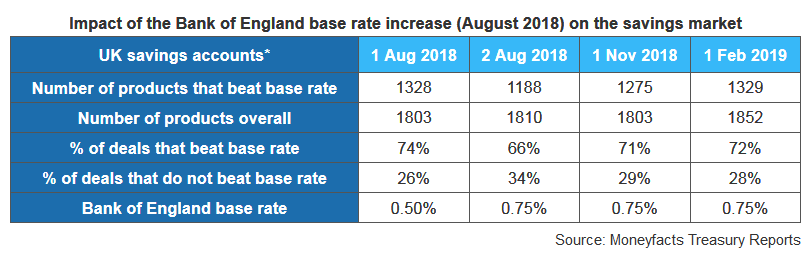UK Savings Market Recovers Six Months on From Base rate Rise
Personal_Finance / Savings Accounts Feb 18, 2019 - 05:34 PM GMTBy: MoneyFacts
Moneyfacts UK Savings Trends Treasury Report data, not yet published, reveals that the savings market has taken a full six months to price in the 0.25% base rate rise from August 2018 and for the number of products that beat base rate to return to pre-rise levels.
In August 2018, 74% of the savings market beat 0.50%, however on the day base rate rose to 0.75%, the proportion of accounts that beat base rate (0.75%) fell to 66%. After six months of recovery, the market is reaching pre-rise levels, at 72%. Still, over a quarter (28%) of the savings market today do not pay above 0.75%, so there is still more room for improvement.

Rachel Springall, Finance Expert at Moneyfacts, said:
“It is widely assumed that any base rate rise would ripple through the savings market within just a couple of months but, as we have seen since the Bank of England rate rise in August 2018, it has taken six months for the market to finally near pre-rise levels. Not only this, but the total number of savings products now available has also returned to the level seen before the increase, rising by 141 over the past six months to stand at 1329 – overtaking the number seen at the beginning of August last year (1328).
“Despite more choice for savers, the number of products that do not beat 0.75% today still account for more than a quarter of the savings market, which highlights the necessity to revisit any variable rate accounts that may have been overlooked since the rate rise, as consumers could be earning less than they think. As an example, in the six months following the increase, Barclays Bank passed just 0.05% of the 0.25% rise onto its Everyday Saver, up from 0.20%, to now pay 0.25% today (based on a £10,000 deposit).
“Indeed, the biggest high street bank brands (Barclays Bank, Halifax, HSBC, Lloyds Bank, NatWest/RBS, Santander, TSB) still pay less than bank base rate on their easy access accounts. It is estimated that easy access accounts overall hold over £350bn in funds, despite underwhelming competition in this market, according to a study by the Financial Conduct Authority.
“As it stands, providers who are offering the top rates in the market, such as challenger banks, will need to continue to build up trust with savers who may well be apathetic to switch. The cost of convenience – leaving deposits languishing in poor-paying accounts – should not be ignored, especially as rates can be as low as 0.10%.
“Consumers must therefore not rely on Bank of England rate rises to improve the market instantaneously, as it may take a while for providers to pass any rise on – a trend we also saw after the rate rise in 2017. Simply put, savers are likely to secure a better return if they switch, and the challenger brands should use this fact as an opportunity to entice new customers.”
*Savings account numbers include all interest-paying options for variable and fixed rates and include ISAs.
moneyfacts.co.uk is a financial product price comparison site, launched in 2000, which helps consumers compare thousands of financial products, including credit cards, savings, mortgages and many more. Unlike other comparison sites, there is no commercial influence on the way moneyfacts.co.uk ranks products, showing consumers a true picture of the best products based on the criteria they select. The site also provides informative guides and covers the latest consumer finance news, as well as offering a weekly newsletter.
MoneyFacts Archive |
© 2005-2022 http://www.MarketOracle.co.uk - The Market Oracle is a FREE Daily Financial Markets Analysis & Forecasting online publication.



